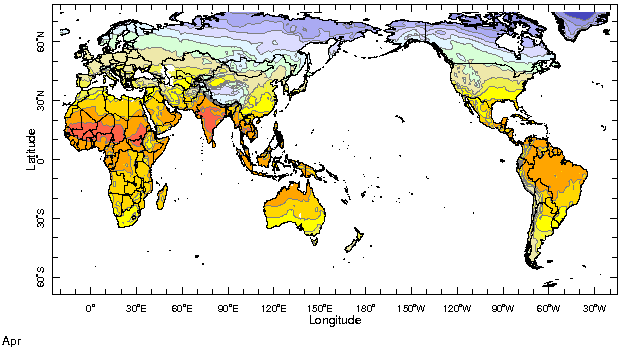|
IRI Climate Digest
May 2006
April Global Climate Summary
Climatological Background
In April, the sun's migration into the Northern Hemisphere has begun, bringing springtime to the northern mid-latitudes. The monsoon systems which still linger south of the equator will move northward following the solar heating of the continents in the next two months. In the Southern Hemisphere fall has arrived, with cooler temperatures and a strengthening of the mid-latitude storm tracks.
Monthly Mean Temperature (1961-1990), data from the Climate Research
Unit, University of East Anglia


Monthly Mean Precipitation (1961-1990), data from the Climate Research
Unit, University of East Anglia


Temperatures
April witnessed an end to unusually cold conditions in northern Europe, with most of the area west of the Urals experiencing temperatures above the long-term average. South-central Asia continued to experience warmer-than-average temperatures while temperatures in Siberia and northern China were below average during the month. With the exceptions of Alaska, northwestern Canada, and California's Central Valley all of North America from Mexico northward to the Arctic regions of Canada experienced well above-average temperatures during April. The continental United States had its warmest April in over 100 years of record. In the Southern Hemisphere, colder-than-average conditions dominated much of Australia from New South Wales to Western Australia, while above-average conditions continued in Argentina northward to Bolivia.
Temperature Difference from the 1961-1990 mean, with data
from NCEP Climate Prediction Center, CAMS.


Precipitation
Large-scale precipitation patterns continued to reflect the influence of modest La Niņa conditions, most notably with the enhanced rainfall in the western equatorial Pacific from Queensland, Australia, through much of Indonesia. However, even in this core La Niņa region, a closer analysis of rainfall shows a complex pattern of wet and dry conditions over the islands of New Guinea, Borneo, and Sumatra during April, consistent with the weakening of the cold episode. Northeastern Brazil, northern Argentina, and southern Peru experienced above-average rainfall while Uruguay, southeastern Brazil, and much of Colombia had a deficit of rainfall during April. In North America, wetter-than-average springtime conditions were experienced from California northward into Idaho, but dry conditions continued along coastal Washington state as well as much of the southern United States. Some relief from drought conditions was experienced in eastern Africa, including the hardest hit areas in Ethiopia, Kenya, and southern Somalia. Above-average rainfall was also experienced in Mozambique and much of Tanzania as well as along the west coast countries of Namibia and Angola. With the exception of south-central Europe, most of that continent was relatively dry during April.
Precipitation Difference from 1979-2000 mean, with data
from NCEP Climate Prediction Center, CAMS-OPI.


Oceanic Conditions
The only evidence of the waning La Niņa cold episode in the sea surface temperature fields is a small area of cooler-than-average conditions along the coast of Ecuador and northern Peru. There are no other significant sea surface temperature anomalies in the equatorial Pacific or equatorial Indian Oceans. The tropical North Atlantic shows above-average temperatures. Areas of positive temperature anomalies are evident in the South Pacific, the South Atlantic, and much of the North Atlantic. The southern Indian Ocean shows cooler-than-average temperatures west of Australia and warmer-than-average temperatures along the east coast of southern Africa and eastward of Madagascar.
Monthly Sea Surface Temperature Difference from the 1971-2000 mean,
with data from the Environmental Modeling Center, NCEP/NOAA.


Contents |
Special |
Impacts |
Climate |
Forecast
|

